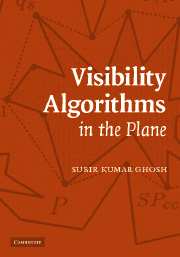2 - Point Visibility
Published online by Cambridge University Press: 14 August 2009
Summary
Problems and Results
Determining the visible region of a geometric object from a given source under various constraints is a well-studied problem in computational geometry [30]. The visibility polygon V(q) of a point q in a simple polygon P is the set of all points of P that are visible from q. In other words, V(q) = {p ∈ P|q sees p}. A similar definition holds in a polygon with holes or an arrangement of segments. The problem of computing the visibility polygon V(q) of a point q is related to hidden line elimination problem and it is a part of the rendering process in computer graphics [115]. Figure 2.1 shows V(q) in a simple polygon, a polygon with holes, and a line segment arrangement. By definition, any V(q) is a star-shaped polygon and q belongs to the kernel of P. The visibility polygon of a point in a line segment arrangement may not be always bounded.
Let ab be an edge on the boundary of V(q) such that (i) no point of ab, except the points a and b, belong to the boundary of P, (ii) three points q, a and b are collinear, and (iii) a or b is a vertex of P. Such an edge ab is called a constructed edge of V(q).
- Type
- Chapter
- Information
- Visibility Algorithms in the Plane , pp. 13 - 45Publisher: Cambridge University PressPrint publication year: 2007



